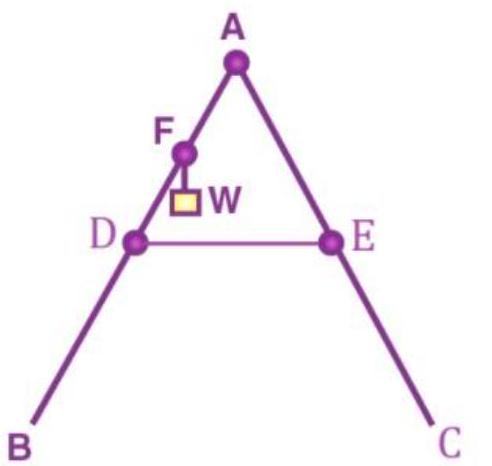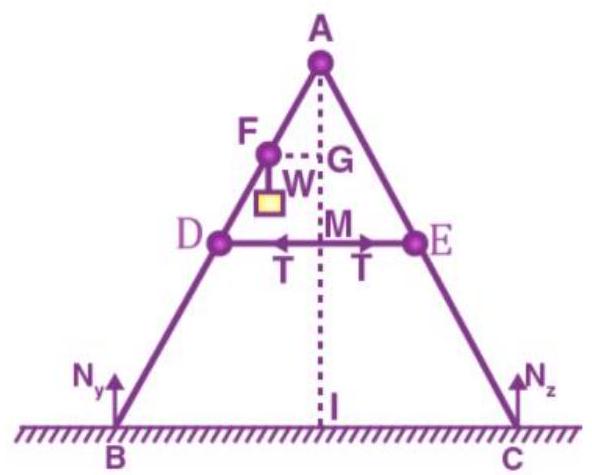
Solution:
The above figure can be redrawn as,

where,
![]() is the force being applied by floor point
is the force being applied by floor point ![]() on the ladder
on the ladder
![]() is the force being applied by floor point
is the force being applied by floor point ![]() on the ladder
on the ladder
The tension in the ring be ![]()
![]()
![]()
![]()
Mass of the weight is given as ![]()
Now,
We will construct a perpendicular from ![]() on the floor
on the floor ![]() . This will intersect DE at mid-point
. This will intersect DE at mid-point ![]() .
.
![]() and
and ![]() are similar
are similar
![]()
This makes I the mid-point of ![]() .
.
![]()
![]()
![]()
D is the mid-point of ![]() .
.
Thus,
![]()
On using equations (1) and (2), we get:
![]()
As a result, ![]() is the mid-point of
is the mid-point of ![]() .
.
FG || DH and we concluded that F is the mid-point of AD. This will make G the mid-point of AH.
ΔAFG and ΔADH are similar
∴ FG / DH = AF / AD
FG / DH = 0.4 / 0.8 = 1 / 2
FG = (1/2) DH
Since, H is the midpoint of the rope, so DH = 0.5/2 = 0.25 m
= (1/2) × 0.25 = 0.125 m
In ΔADH:
AH = (AD2 – DH2)1/2
= (0.82 – 0.252)1/2 = 0.76 m
The downward force should be equal to the upward force for translational equilibrium of the ladder, so,
NC+ NB = mg = 392 N . . .. . . . . . . . . . . . . . ( 3 ) [ mg = 9.8 x 40 ]
Rotational equilibrium of the ladder about A is can be calculated as,
-NB × BI + FG x mg + NC × CI – T × AG + AG × T = 0
-NB× 0.5 + 392× 0.125 + NC × 0.5 = 0
(NC – NB) × 0.5 = 49
NC – NB = 98 . . . . . . . . . .. . . .. . .. . . ( 4 )
On aAdding equations (3) and (4), we get:
NC = 245 N
NY = 147 N
Rotational equilibrium about AB
Considering the moment about A
-NB × BI + FG x mg + T × AG = 0
-245× 0.5 + 392 × 0.125 + 0.76 x T = 0
∴ T = 96.7 N.
